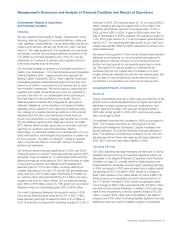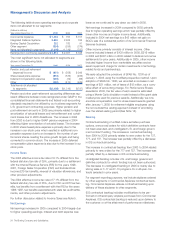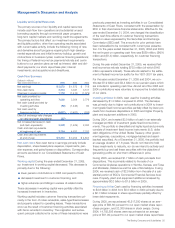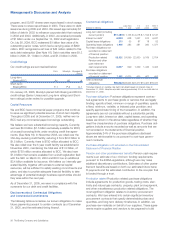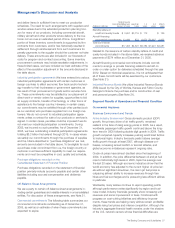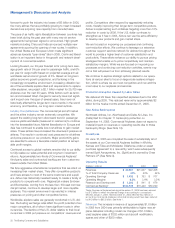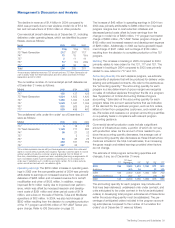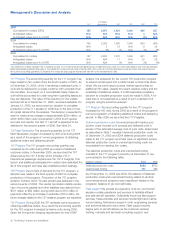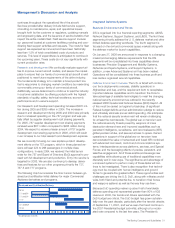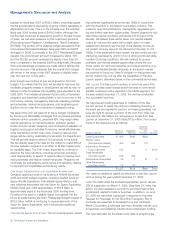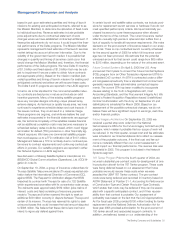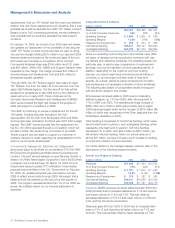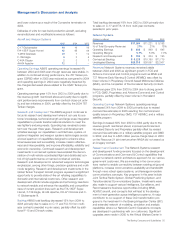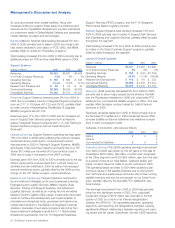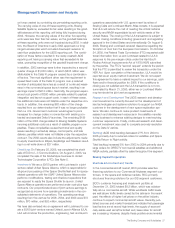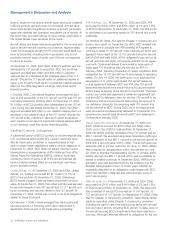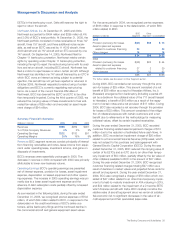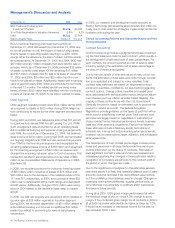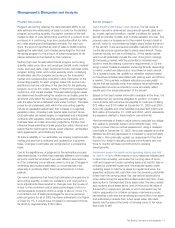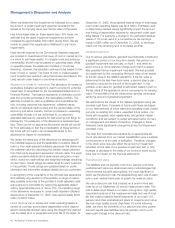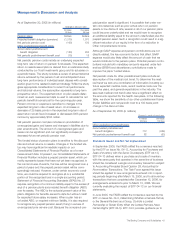Boeing 2005 Annual Report Download - page 35
Download and view the complete annual report
Please find page 35 of the 2005 Boeing annual report below. You can navigate through the pages in the report by either clicking on the pages listed below, or by using the keyword search tool below to find specific information within the annual report.Management’s Discussion and Analysis
based in part upon estimated quantities and timing of launch
missions for existing and anticipated contracts, referred to as
the Mission Manifest, to determine the allocation of fixed costs
to individual launches. Revenue estimates include probable
price adjustments due to contractual statement of work
changes where we have established contractual entitlement. If
these price adjustments do not occur, it could impact the finan-
cial performance of the Delta programs. The Mission Manifest
represents management’s best estimate of the launch services
market taking into account all known information. Due to the
volatility of the government launch market, it is possible that
changes in quantity and timing of launches could occur that
would change the Mission Manifest and, therefore, the financial
performance of the Delta programs. We have Delta IV inventory
of $1.0 billion and fixed assets of $1.0 billion that may be sub-
ject to impairment if we are unable to obtain future contracts
and appropriate pricing. Based on the mission manifest (esti-
mated quantities and timing of launch missions for existing and
anticipated contracts) we believe we will recover these costs.
The Delta II and IV programs are reported in the L&OS segment.
Satellites As is the standard for the commercial satellite indus-
try, contracts are fixed-price in nature and include on-orbit
incentive payments. Many of the existing satellite programs
have very complex designs including unique phased array
antenna designs. As technical or quality issues arise, we have
continued to experience schedule delays and cost impacts. If
the issues continue, they could result in a material charge.
These programs are ongoing, and while we believe the cost
estimates incorporated in the financial statements are appropri-
ate, the technical complexity of the satellites creates financial
risk as additional completion costs may become necessary or
scheduled delivery dates could be missed, which could trigger
termination for default (TFD) provisions or other financially sig-
nificant exposure. We have one commercial satellite program
that could expose us to a TFD notification risk of $137 million.
Management believes a TFD is not likely due to continued per-
formance to contract requirements and continuing contractual
efforts in process. Our satellite programs are reported in either
the Network Systems or L&OS segments.
See discussion of Boeing Satellite Systems International, Inc.
(BSSI)/ICO Global Communications (Operations), Ltd. (ICO) liti-
gation in note 24.
On September 10, 2004, a group of insurance underwriters for
Thuraya Satellite Telecommunications (Thuraya) requested arbi-
tration before the International Chamber of Commerce (ICC),
against BSSI. The Request for Arbitration alleges that BSSI
breached its contract with Thuraya for sale of a 702 Satellite
which experienced anomalies with its concentrator solar arrays.
The claimants seek approximately $199 million (plus claims of
interest, costs and fees) consisting of insurance payments
made to Thuraya and further reserved the right to seek an
additional $39 million currently in dispute between Thuraya and
certain of its insurers. Thuraya has reserved its rights to seek
uninsured losses that could increase the total amount disputed
to $365 million. We believe that these claims lack merit and
intend to vigorously defend against them.
In certain launch and satellite sales contracts, we include provi-
sions for replacement launch services or hardware if we do not
meet specified performance criteria. We have historically pur-
chased insurance to cover these exposures when allowed
under the terms of the contract. The current insurance market
reflects unusually high premium rates and also suffers from a
lack of capacity to handle all insurance requirements. We make
decisions on the procurement of insurance based on our analy-
sis of risk. There is one contractual launch currently scheduled
for the second quarter of 2006 for which full insurance cover-
age has not been procured. We estimate that the potential
uninsured amount for that launch could range from $65 million
to $315 million, depending on the nature of the uninsured event.
Future Combat Systems On April 5, 2005 the U.S. Army
announced that it plans to convert the Future Combat Systems
(FCS) program from an Other Transaction Agreement (OTA) to
a standard DoD contract. An OTA is contracted under a differ-
ent congressional authority than a standard DoD contract and
generally imposes fewer administrative contractual require-
ments. The current OTA has been modified to incorporate
clauses relating to the Truth in Negotiations Act, Cost
Accounting Standards, and the Procurement Integrity Act. We
signed a Federal Acquisition Regulations-based Undefinitized
Contract Authorization with the Army on September 23 and
definitization is scheduled for March 2006. Based on our
assessment of the possible contractual changes, we do not
believe there will be a significant impact to earnings, cash flow
and/or financial position.
Future Imagery Architecture On September 28, 2005 we
received a partial stop-work order from the National
Reconnaissance Office for the Future Imagery Architecture (FIA)
program, which makes it probable that our scope of work will
be reduced. In the third quarter, revised cost and fee estimates
were included in our financial statements to reflect our assess-
ment of the probable outcome. If the final cost and fee out-
come is materially different than our current assessment, it
could impact our financial performance. The revenue loss was
immaterial in 2005. This program is included in the Network
Systems segment.
767 Tanker Program Prior to the fourth quarter of 2004, we
incurred substantial pre-contract costs for development of one
in-production aircraft for the 767 Tanker program. These costs
were being deferred based on our assessment that it was
probable we would recover these costs when we were
awarded the USAF 767 Tanker contract. The pre-contract
costs were being deferred and recorded in inventory based on
AICPA Statement of Position 81-1, Accounting for Performance
of Construction-Type and Certain Production-Type Contracts,
which states that costs may be deferred if they can be associ-
ated with a specific anticipated contract, and if their recover-
ability from that contract is probable. Our assessment of
probability was based on the fact that the DoD Appropriations
Act for fiscal year 2005 provided $100 million funding for tanker
replacement and the National Defense Authorization Act for
fiscal year 2005 provided authorization for the procurement of
100 tanker aircraft and associated support contracts. In
addition, we believed, based on our understanding of the
The Boeing Company and Subsidiaries 33


